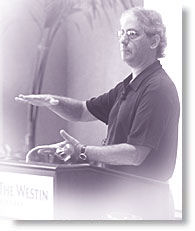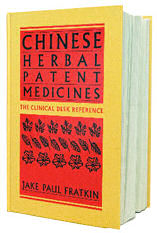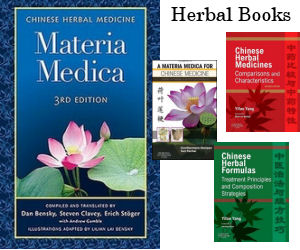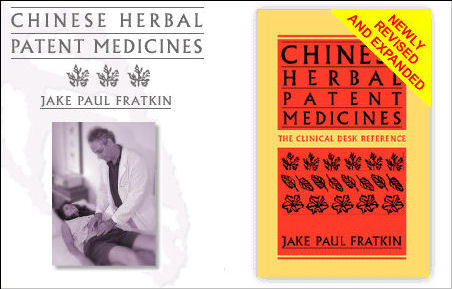Acupuncture & TCM Articles

Articles by Jake Paul Fratkin, OMD, LAc
Jake Fratkin, OMD, LAc, has been in the practice of Oriental medicine since 1978. Following undergraduate and graduate training at the University of Wisconsin in Chinese language and philosophy and pre-medicine, he pursued a seven-year apprenticeship in Japanese and Korean style acupuncture with Dr. Ineon Moon and a two-year apprenticeship in Chinese herbal medicine with Drs. Zhengan Guo and Pak-Leung Lau in Chicago. He also spent a year in Beijing hospitals interning in advanced herbal medicine, specializing in gastrointestinal and respiratory disorders, and pediatrics.  Dr. Fratkin is the author of several books, including Chinese Herbal Patent Medicines: The Clinical Desk Reference, and is the editor-organizer of Wu and Fischer's Practical Therapeutics of Traditional Chinese Medicine. In 1999, he was named the "Acupuncturist of the Year" by the American Association of Oriental Medicine.
Dr. Fratkin is the author of several books, including Chinese Herbal Patent Medicines: The Clinical Desk Reference, and is the editor-organizer of Wu and Fischer's Practical Therapeutics of Traditional Chinese Medicine. In 1999, he was named the "Acupuncturist of the Year" by the American Association of Oriental Medicine.
Chinese Herbal Patent Medicines: The Clinical Desk Reference
Hardback book, 1198 pages. This volume covers 1360 products, including 550 GMP level products and all of California FDB analysis on 505 products. Includes information on endagered animals, heavy metals, and pharmaceuticals. The text is organized into 12 groups, with a total of 109 chapters and includes material by Andrew Ellis, Subhuti Dharmananda, and Richard Ko. Over 80 pages of full-color photos (with English and Chinese cross-reference). Fully indexed.
Making Chinese Herbal Formulas into Alcohol Extracts
For practitioners of Chinese herbal medicine in North America, one of the most significant obstacles has been patient compliance. While it is possible to initially convince patients to take water-extracted decoctions, enthusiasm wanes dramatically after three weeks. There are three main reasons for this: 1) The taste is not agreeable. 2) The patient does not like the effort and time that it takes to boil down herbs on a daily basis; also, the smell in the house is often objectionable. 3) The price is excessive, often costing the patient $3 - 7 per bag per day, or $60 to $140 per month. In America, we often use 100 grams of herb per bag, and try to get three doses out of it, lasting one and a half days. In China, one bag might be two to three times the dosage, and meant to last one day. Which is to say that this approach, when practiced in North America, is often less strong (and effective) as is practiced in China.

So, compliance is affected by hassle and cost. Practitioners, many of whom recognize this problem, have tried to circumvent it by using ready made Chinese herbal products. This, of course, inhibits the herbalist's effectiveness in customizing an individual formula. For those herbalists wishing to individualize patient's prescriptions, there are three methods for reducing the cost and increasing compliance on the part of the patient.
The first method is to combine individual herbs as extracted granules, from such companies as Sun Ten-Brion, Mintong, and Qualiherb. These are applied in 2-3 gram dosages either directly on the tongue and swallowed with water, or stirred in water and drunken. The advantages of this approach is good compliance by the patient, and easy shelving of the two to three hundred herbs the herbalist will wish to keep in stock. The disadvantage is cost: it will cost the practitioner quite a lot of money to initially invest in these herbs ($2000-$6000), and the cost to the patient is at least $2.00 per day, or $60 per month.
The second method was recommended to me by my original teacher, Dr. Guo, Zhen-gang, who practices in Chicago. This method requires the herbalist to carry in stock all of his herbs in the raw form. A prescription is made, using between 6 and 9 grams for the daily dose. The herbal prescription is reduced to a fine powder by electrical grinder. The powder is given to the patient, who is instructed to take one large teaspoon (about 3 grams), add one cup of boiling water, cover and wait ten minutes, then strain. Two to three doses are taken per day. Dr. Guo believes this method to be as effective as decocting herbs (most of whose medicinal value goes up in steamy smoke). Patient compliance is good, because there is no real effort in preparing the decoction, but there is still the issue of tasting and drinking a cup of Chinese herbs. Cost is very effective to the patient, where the herbalist can charge less that a dollar for a daily dose, or $30 for a month's supply.
A variation on this theme is to have the herbalist or the patient put the powdered herbs into capsules. A patient would need to take six to nine capsules, twice a day. There are now convenient capsule makers (available from TCM, Spring Wind, and Frontier Herbs, among other sources) for the herbalist or the patient. I should point out, from a practitioner's point of view, that it takes about 20 minutes to make one hundred capsules, and one should give some thought to this use of one's time.
The third method involves making a customized herbal formula into an alcohol-extracted tincture. This is the method I use, and the one I would like to talk about in detail. The advantages of an alcohol-extracted tincture include the following: 1) the herbalist retains the ability to customized the formula. 2) The herbalist continues to work with raw herbs, and thereby can gauge the quality of the herb, and also keep his/her hands in raw herbs (which I think appeals to all Chinese herbalists). 3) Compliance by the patient is excellent. The patient takes four squirts with one inch of boiling water, waits ten minutes, and drinks, doing this two times per day. In many cases, the patient can even take it without using boiling water. 4) The cost to the patient is about $1.40 per day ($42 per month) at the recommended dosage. Of course, for children, it is less.
I have been using this method since 1988 (6 years), and I truly believe that the efficacy is as strong as water decoction. I have seen ovarian cysts reduced within four weeks, and successful results for a wide variety of complaints including yin deficiency cough, phlegm-damp cough, dysmenorrhea, intestinal inflammation, asthma, traumatic bone injury, etc., etc. Initially, I encountered resistance to this idea from traditional practitioners, mainly because it was new and unproved. The main valid concern was that the energetic aspects of the Chinese materia medica were described based on water extraction, and that alcohol extraction might distort or change the energetic properties of the herbs. This may be so, but in my experience (six years of prescribing traditional water extracted decoction, followed by six years of giving alcohol/water extracted tinctures), I believe that the effects are very much the same. Bear in mind that the method I describe below is based on a very strong herb to alcohol ratio (3-4 x as strong as many commercially available alcohol extracted herbal tinctures). Also, the liquid solution is not just alcohol: fifty percent is alcohol and fifty percent is water, allowing for the necessary polysaccharide extraction which is best done in water.
A water extraction requires a minimum of 100 grams for a day and half's dosage. By comparison, I use 100 grams of herbs for a 4 oz solution, which will last 21 days. The minimizing of stocking and buying herbs should be appreciated. The alcohol-water extraction, working from powdered herbs, is therefore thirteen times more efficient than water extraction of bulk, unpowdered herbs.
Although initially derided by herbalists, I am now receiving many requests asking about this method, not only from long established American practitioners, but also from Chinese herbalists living in this country. Their motivation is consistent: how can one provide individualized Chinese herbal formulas that are inexpensive, that the patient will take over a long period of time, and that are as effective as water decoctions? In response to these requests, I am detailing the steps here.
Equipment needed.
1 - Commercial herb grinder ($450-$650*), or a Oster industrial bartender blender ($125).
5 gal. - Grain alcohol (95%) ($150.) McCormick Grain, (800) 825-0377 Good quality water
1 - 1/2 gallon glass bottle and cap (for alcohol-water stock solution)
1 - High-quality garden shears
1 - Brass mortar and pestle
4-8 - Plastic soda bottles, 2 liters, or 2 quarts with screw-on caps;
or industrial chemical plastic (Nalgene) 1/2 gallon bottles; or industrial glass 1/2 gallon bottles
4-8 - Stainless steel bowls
4-8 - Bell ball jars
4-8 - Dinner plates (to cover steel bowls; plastic is okay)
4-8 - Shallow plastic cups (e.g. for potato salad)
or hard plastic bowls (Rubbermaid-K Mart)
1 - Long wooden spoon
1 - Flat wooden rice spatula
1 - Small plastic funnel (for the 2 oz. or 4 oz. bottles)
1 - Large plastic funnel, 1/2 gallon (to make stock solution), Cotton balls, Unbleached coffee filters, number #6
1 case - 2 oz brown dropper bottles,
1 case - 4 oz brown dropper bottles
(Industrial Container, (801) 972-1561) Pad of Post-Its ®, Individual labels (customized at a printer),
Method:
1. Prepare raw herb prescription. For a 10 day supply (2 oz. bottle), make a formula of 50 grams. For a 21 day supply (4 oz. bottle), make a formula of 100 grams.
2. Grind the herbs into a fine powder. Use a commercial herb grinder, or an Oster industrial bartender blender. Certain herbs need to be cut into smaller pieces with the garden shears prior to grinding, e.g.: Astragalus Huang Qi. Other herbs may need to be crushed, such as shells, with a brass mortar and pestle. If possible, certain herbs can be bought in a powder state: e.g. Ginseng Ren Shen, Codonopsis Dang Shen, Ostrea Mu Li.
3. Pour the powder in a stainless steel bowl. Mix the powder with the stock solution that is 50% good quality water, and 50% grain alcohol (95%). This stock should be kept as a pre-mixed solution, and stored in the 1/2 gallon glass bottle. The mixture should make the powder the consistency of a wet sawdust - not too wet, and not too dry. Cover well with a plate. Let sit for 18-24 hours. Mark on Post-It ® with name, date, time, and quantity (4 oz or 2 oz).
4. Use plastic soda bottles, chemical naprene bottles, or glass bottles that are 2 liters (2 quarts). Cut off base, retaining neck. Place two cotton balls into mouth, and ram down with a long wooden spoon, using the handle. Screw on cap loosely. Take two unbleached coffee filters, number #6, placing one within the other. Place the filters into the upside down bottle; use your fingers to carefully widen the filters to receive the herbs. Place the upside down bottle into the Bell ball jar.
5. Using a flat wooden rice spatula, scoop up the herb and pack it into the filter. Cover with the water-alcohol solution from the stock bottle: for two week supply, use exactly 2 oz. of solution; for a four week supply, use exactly 4 oz. of solution. Cover the open end of the bottles with the shallow plastic insert (the potato salad plastic cup, or the Rubbermaid plastic bowl). Place the Post-It ® label with name, time, date, and quantity on top of the plastic insert.
6. Allow the solution to drip through. This will take 30 minutes to 2 hrs, depending on how loose or tight the screw-on cap is. When completely dripped, repeat by pouring the now dark solution through the top again, a second time. You are doing two complete pourings. I recommend letting them slow drip for one to two hours.
7. Funnel liquid into 2 oz or 4 oz brown dropper bottles. Label with name of patient, date given, and instructions. Patient takes one teaspoon (5 squirts), 2 times per day. Children take 2-5 squirts, 2 x day. Cover with one inch of boiling water to drive off the alcohol, wait ten minutes, then drink alone. Some patients may take with one inch of regular water (for better compliance). Do not take directly into the mouth. Advise not to take with meals (up to 20 minutes before, or starting one hour later).
Herb Grinders. The RT grinder (Rong Tsong Iron Works, Taipei; @$450) is very fast (thousands of rotations per minute). It can grind from 3 grams to one pound. For 105 g., I recommend 30 seconds. Replace blades when dull. The blades may be difficult to remove. TCM, INC. offers a $650 grinder, from Taiwan, that is the equal of the RT, and with easy to replace blades. They also offer the RT unit. Heavy duty industrial herb grinders can be bought from the following distributors:
TRADITIONAL CHINESE MEDICINE, INC. 2746 N. Durfee Ave, #K
El Monte, CA 91732
(626) 401-3737
FAX: (626) 401-1968
MAYWAY USA
1338 Cypress St
Oakland, CA 94607
(800) 262-9929
FAX: (800) 909-2828
SPRING WIND HERB COMPANY 2315 Fourth St
Berkeley, CA 94710
(800) 588-4883
FAX: (510) 849-4886
It is important to encourage the patient to use the small amount of boiling water to drive off the alcohol. This is essential in all heat conditions, and it also makes the formula more palatable. If the patient is less inclined to take the trouble, then have them add to regular water. Take without food, except in cases where taking the herbs causes nausea.
Formulas are made in two steps. In step one, the prescription is ground into powder, and mixed with stock solution. This takes about 15 minutes, once you are up to speed. I have an assistant do this part for me.
The second step is done the next day (18-24 hrs later). In this step, the wet herb mass is stuffed into the bottles prepared with cotton balls and filters. We pour and drip three times, which will require three hours.
I am indebted to Charlie Jordan of Dragon River Herbals, New Mexico, and Clarissa Smith, formerly of Wyoming Wildcrafters, for teaching me this method. Again, I believe it is an excellent and economical approach for providing individualized herbal formulas to your patients.
 
|
